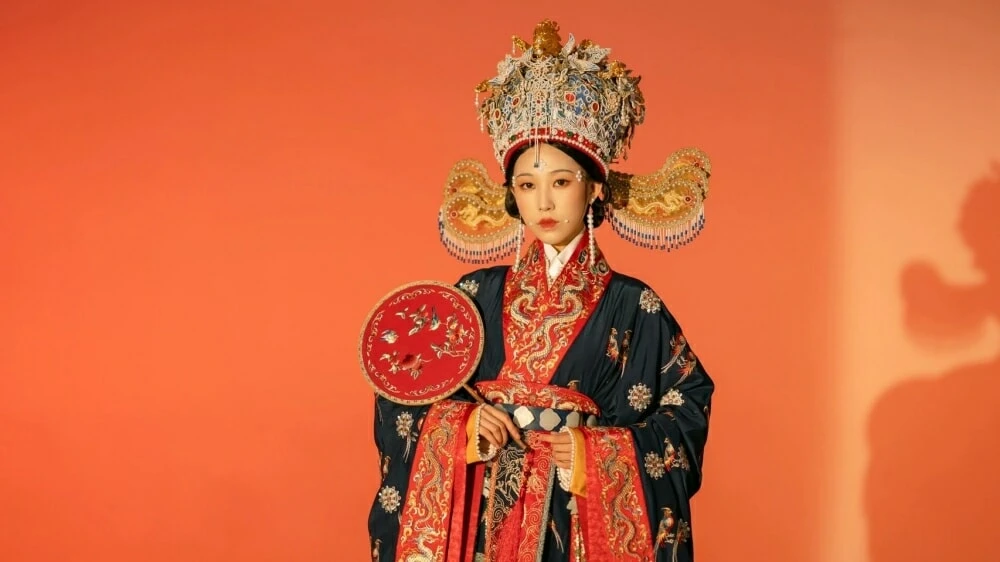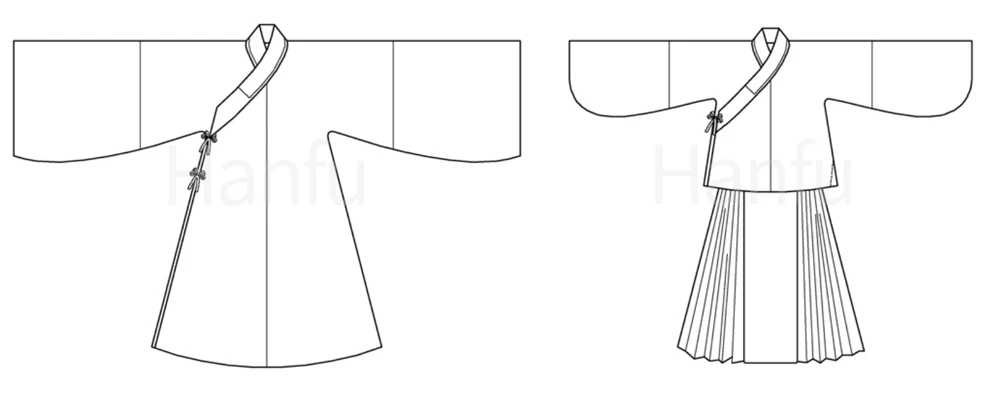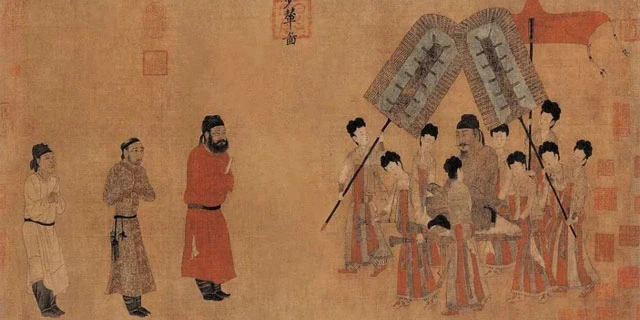Must See
Everything About Hanfu - You Will Be Interested In

Fashion
Find the latest China's fashion, Hanfu, Han element, cheongsam qipao and other Chinese retro and fashion clothing.
-
A recent photoshoot featuring actress Zhang Yuxi (张予曦) has captivated social media, not for a new drama role, but for a breathtaking interpretation of bridal wear. Set against the backdrop of a windswept beach, the images present her not merely as a bride, but as a mythical figure emerging from the sea itself. The series transcends conventional wedding photography, framing a narrative where fashion, nature, and personal expression converge into a single, powerful visual statement. This isn't just a dress photographed near the ocean; it is a gown conceptually born from it, challenging traditional notions of bridal sanctity with a wave of liquid romance and effortless grace. The Gown as Art At the heart of this spectacle is the dress itself, a masterclass in thematic design. The sweetheart neckline bodice, embroidered with pearls and delicate feather-like motifs, catches the light with a subtle, shimmering effect. This careful embellishment creates the illusion of sunlight dancing on water, a direct translation of the ocean's sparkle into wearable art. The fabric appears alive, its texture and details meticulously crafted to echo the natural environment surrounding her. The silhouette is a defining feature. A fitted mermaid cut flares into a cascading train of layered…
-
The image stopped countless scrolling fingers mid-motion. There, bathed in the ethereal lavender haze of blooming wisteria, stood actress Zhang Yuxi (张予曦), transformed. At 34, she was not merely wearing a costume but embodying a vision, a seamless blend of person, place, and tradition. Her photoshoot, set against the unexpected backdrop of European-style architecture draped with cascading purple flowers, became an overnight sensation. It was more than a celebrity fashion spread; it was a statement. This moment captured a powerful contemporary dialogue between a modern Chinese woman and an ancient sartorial art form, suggesting that true elegance is not bound by era or age, but is a living, breathing continuum. A Portrait in Violet The genius of the look lies in its meticulous harmony. Zhang Yuxi's Hanfu is a soft symphony in powdered lavender and plum, its delicate embroidery tracing floral patterns that seem to echo the living wisteria around her. The ensemble avoids ostentatious grandeur, opting instead for a refined, almost poetic grace. A pivotal detail is the outer robe, trimmed with a subtle, downy fringe. This touch adds a tangible texture and depth, preventing the flowing silks from appearing flat, and introduces a whisper of delicate luxury. Every…
-
A recent public appearance by singer and actress Song Qian (宋茜) has set fashion forums ablaze. Her outfit, a masterclass in confident color blocking, immediately commands attention. It’s a look that doesn’t just walk into a room—it announces its arrival. By pairing a vibrant, patterned blouse with a sleek, minimalist skirt, she achieves a balance that feels both daring and perfectly controlled. This ensemble transcends a simple style choice; it represents a deliberate fashion statement from an artist known for her sartorial intelligence. Deconstructing the Top The foundation of the look is the sapphire-blue floral blouse. This isn't a shy pastel, but a rich, jewel-toned piece that makes a powerful first impression. The print adds a layer of complexity, preventing the solid color from feeling overwhelming. A deep V-neckline introduces a hint of allure, skillfully balanced by the shirt's overall structure. This detail draws the eye while maintaining an air of sophistication. Further elevating the top are its thoughtful design elements. Gently gathered sleeves create a soft, blousoned effect that contrasts with the sharpness of the short skirt. This subtle volume adds movement and a touch of romance to the silhouette. A delicate drawstring at the neck or waist allows…

Wear Hanfu
About different styles of hanfu wear recommended: traditional hanfu, modern hanfu, hanfu inspired, hanfu accessories, etc. Also includes tips on how to wear hanfu during seasons and traditional festivals.
-
A recent period drama costume has ignited curiosity about ancient Chinese fashion. Actor Liu Xueyi (刘学义) appeared in promotional images wearing a high-necked inner garment, a style unfamiliar to many modern viewers. Fans quickly dubbed it the "neckless" undershirt, sparking online discussions about its historical accuracy. This sartorial detail is not a costume designer's fantasy but a potential revival of a real, yet enigmatic, item from the Han Dynasty known as the Quling (曲领). The debate surrounding Liu's attire mirrors a century-old academic puzzle: what exactly was this garment depicted on countless clay figurines? Clay Figurine Clues Archaeologist Zeng Zhaoyu (曾昭燏) provided crucial evidence in her study of pottery figurines from Pengshan (彭山) cliff tombs in Sichuan. She noted a distinct, raised ring around the necks of many figures. This was not a sculptural flourish or a folded collar. The ring had clear, parallel seams and a defined edge, suggesting it was a separate, detachable item with its own structure. The most compelling proof came from two unique "nursing mother" statues. On these, the outer robe was open, revealing a separate piece of cloth covering the chest. Zeng observed this chest piece was continuous with the raised ring at the…
-
Yue Yunpeng, why don't you wear your clothes properly! In the ancient costume drama The The Lychee Road, when Yue Yunpeng's character Zheng Ping'an makes his first appearance, he is sloppily dressed and wears what seems like a "mini skirt". The CP combination with Lei Jiayin's Li Shande makes people can't help laughing. Is this "mini skirt" deliberately done for the drama effect or did such a garment really exist in history? First, let's state the conclusion. This is a common Tang-style inner garment in the round - necked robe, which can be simply called "Banbi" (半臂) according to its appearance features. Generally speaking, this kind of Banbi inner garment has two functions. In the Tang Dynasty, both civil and military skills were highly valued. This inner garment can support the shoulder contour of the outer round - necked robe, making the figure look more upright. Also, it can be conveniently worn with the chest exposed in hot summer or during sports. Since it is used as an inner garment, natural and breathable materials such as linen are usually used. "Banbi" also has another name, "Banxiu" (半袖). It is a very special short - sleeved top in ancient China. Its…
-
The rustle of embroidered silk now echoes from Shanghai's Tianzifang to Xi'an's ancient walls as international travelers embrace hanfu with infectious delight. What began as cultural curiosity has blossomed into a full-blown transnational phenomenon, with foreign influencers and tourists donning Ming dynasty robes and Tang-style ruqun to create viral content that transcends language barriers. This sartorial bridge between eras and continents reveals how traditional Chinese garments are becoming 21st-century cultural connectors. Destination Dressing Historic sites transform into immersive stages where hanfu unlocks deeper travel experiences. In Suzhou's Humble Administrator's Garden, Slavic creator Ana Petrovna floats across zigzag bridges in blush-pink chiffon, her movements harmonizing with centuries-old pavilions. The visual poetry of her ensemble against classical architecture drew thousands of Instagram saves. Urban studios cater to global clients with specialized services. Shanghai's Hanyi Huashang studio stocks plus-size options and offers bilingual styling consultations. "We adjust makeup for deeper eye sockets," explains owner Li Mei, noting 40% of June bookings came from overseas visitors. Iconic landmarks inspire theatrical transformations . At Xi'an's Drum Tower, British photographer Tom Higgins commissioned a dragon-embroidered emperor's robe. "The weight of the gold-threaded cloak made me stand differently—more regal," he laughs. His "Three Imperial Poses" reel trended on TikTok…

Hanfu Making
About Hanfu making, including cutting & sewing patterns for different Hanfu styles.
-
In a recent preview for the period drama Biao Mei Wan Fu (表妹万福), set against a Ming Dynasty backdrop, actress Song Zuer's (宋祖儿) character is seen outdoors wearing what appears to be a structured, clasp-fastened undergarment. This has sparked a fiery online debate: Was it historically accurate for a woman to reveal her inner wear during this era, or is this merely a creative costume design choice? The scene challenges modern perceptions of Ming fashion, often imagined as uniformly modest and restrictive. To understand this sartorial choice, we must delve into the specific garment in question and its place in the private versus public life of a Ming gentlewoman. Zhuyao Unveiled The garment causing the stir is not a modern invention but a historical piece known as a Zhuyao (主腰). Popular during the Yuan and Ming periods, it was sometimes poetically called a "pleasure-binding jacket." Its defining feature was a front opening secured by ties or clasps, a distinct departure from the more common wraparound styles. While the overarching term for inner wear in this period is often debated, the Zhuyao stands out for its tailored construction. Surviving artifacts show it could be worn with or without shoulder straps, which could…
-
The rustle of silk on city streets signals more than a fashion trend. Across China and beyond, young people wearing flowing robes with wide sleeves and crossed collars aren't just dressing up—they're reviving a sartorial language spoken for millennia. Hanfu, the traditional attire of the Han Chinese, carries within its seams profound cultural narratives, aesthetic philosophies, and social codes that transcend mere costume. This resurgence isn't about recreating museum exhibits; it’s a dynamic reclamation of identity. Each fold in the fabric whispers stories of dynasties past, while the vibrant modern interpretations speak boldly to the present. Far from being static relics, these garments embody an evolving dialogue between heritage and innovation. Core Principles Woven in Hanfu distinguishes itself through fundamental design elements that carry deep symbolic weight. The cross-collar forming a "Y" shape visually represents the balance of yin and yang, reflecting ancient cosmological beliefs. The right-over-left lapel served historically as a cultural identifier for Han communities, contrasting with left-over-right styles associated with some neighboring groups. This distinction held such significance that Confucius remarked on its importance in defining civilized society. Equally characteristic are the absence of buttons, replaced by fabric sashes tying the garment, and the signature wide sleeves.…
-
Hanfu is more than fabric; it is China's history draped on the human form. These garments, evolving across millennia, offer a silent narrative of shifting aesthetics, social values, and profound cultural identity. From the foundational rituals of the Qin-Han era to the cosmopolitan flair of the Tang and the introspective elegance of the Song, each dynasty imprinted its spirit on sleeves, collars, and flowing skirts. This journey reveals how Hanfu served as both a mirror and a maker of its time, its threads weaving a continuous story of civilization. Qin-Han Foundations The unification under Qin and Han established Hanfu's core grammar. Garments became instruments of order and ritual. The defining principle was "upper garment, lower skirt", combined with the distinct right-over-left collar closure. This structure conveyed dignity and a connection to cosmic principles. Colors held deep meaning: profound black for heaven, vibrant vermillion for earth. Predominant fabrics were sturdy hemp and coveted silk, often adorned with symbolic patterns like swirling clouds and thunder motifs, reflecting reverence for nature's power. The Quju Shenyi (曲裾深衣) stood paramount. It's wrapped, overlapping panels circled the body multiple times, flaring dramatically at the hem. This complex construction signified formality and status, worn by both men…
-
Last Friday 3/17 I was invited to a local Chinese school to give a small talk on hanfu! The aim was to share hanfu culture with more people here and to present an example to the kids of what doors can be opened to you by maintaining language skills. A little background—I myself attended this once-a-week school from kindergarten up until 6th grade, upon which I pulled out of the school to invite the Chinese teacher that taught me in 6th grade to tutor me at home privately. She was a great tutor and a key part of inspiring my interest in ancient Chinese culture through poetry, history, and more, keeping me engaged while analyzing Tang Dynasty shi and Song Dynasty ci. As I got busy, I stopped the tutoring when I was in 10th grade—and I was introduced to the concept of hanfu not even a few months later! I’ve kept up communication with this teacher for a while (whose name I won’t disclose for privacy reasons) and visited her in Taiwan throughout the years. This year she came back to teach at the local chinese school and invited me to give a talk on hanfu there. For the…
-
I made my first real Hanfu based on patterns from this website. First outing at the beach, with dragons and all. Here is an article with much details on my sewing journey.
-
Wearing armor, riding a horse, holding a traditional weapon, fighting on the battlefield. Such a scene may have appeared in the dreams of many people when they were young. But there is a person who turned the traditional Chinese armor in the dream into reality, he is the first person to restore the ancient armor of the Tang and Song dynasties, Wen Chenhua (温陈华). He has highly restoration the armor of the Song dynasty, which has been lost in China for 700 years, after 6 years. He founded the Lian Kai Tang (炼铠堂), and with his own strength, he promoted the obscure armor restoration craft, and let Chinese armor on the world-class combat stage. #01 The first person in traditional Chinese armor restoration There are only about 1000 armor restorers in China, 90% of them are Wen Chenhua's students, and for 40 years, he has been restoring Jiazhou (甲胄, traditional Chinese armor) to the extreme. On Wen Chenhua's social platforms profile, there is only a simple sentence "Top Chinese Jiazhou maker" as an introduction. However, he has shared a lot of armor design drawings and finished armor photos, all revealing his deep love for Jiazhou. Traditional armor restoration and…
-
Today, a shower involves stepping into a tiled space, reaching for brightly bottled gels, and enjoying instant lather. But in ancient China, from the dusty courts of the Zhou to the bustling markets of the Qing, bathing was a deliberate practice woven into the social and spiritual fabric. Without modern plumbing or chemistry, people turned to the earth and kitchen for solutions. This narrative isn't about mere cleanliness; it's about a cultural dedication to purity that evolved over millennia, using everything from grain runoff to animal organs. The story of their bathing rituals reveals a sophisticated, resourceful approach to personal care that rivals our own in ingenuity and intent. Bathing Rituals In ancient China, washing was codified. The classic text Book of Rites prescribed washing hair every three days and bathing the body every five. This was not a casual suggestion but a recognized standard for refinement and health. During the Han Dynasty, this principle was institutionalized for officials, who were granted a "rest and bath" day every fifth day to attend to personal hygiene. Such practices underscored that cleanliness was both a private duty and a public expectation. The language itself was precise. The act of cleansing was divided…
-
Imagine stepping into a bustling street in 16th-century Nanjing. The air is thick with the sizzle of woks and the warm, yeasty smell of steamed buns. From the grand banquets of the scholar-elite to the simple, hearty meals of artisans, the Ming Dynasty was a golden age of Chinese gastronomy. It was an era where culinary traditions solidified, new ingredients whispered of distant lands, and the social ritual of eating reflected a vibrant, commercial society. This wasn't just about sustenance; it was a daily celebration of flavor, technique, and connection. The Staple Foundation The cornerstone of any meal was grain. A clear north-south divide existed: wheat reigned in the arid north, while rice dominated the watery south. Northerners enjoyed a stunning array of noodles, steamed buns, and flatbreads. Southern bowls were consistently filled with fluffy white rice or comforting congee. Interestingly, the New World crops we associate with China today—corn, sweet potato, potato—had arrived by late Ming. Yet, they remained curiosities or famine-relief foods for the poor. A Ming diner would stare blankly at a plate of french fries or a bowl of sweet potato noodles. Their staple world was built on ancient, familiar grains. Meat on the Menu If…
-
In the heart of ancient China, dance was not merely entertainment but a vibrant expression of life and culture, particularly during the Tang Dynasty. This era, known for its economic prosperity and cultural exchanges, saw dance flourish in ways that might surprise modern observers. Today, however, the lively dance floors of old seem a distant memory, leading many to wonder why such a rich tradition has faded. This article delves into the dynamic world of Tang dances, exploring their forms and the historical shifts that quieted their rhythms, offering a fresh perspective on a cultural evolution that resonates beyond time. Vibrant Jianwu Jianwu (健舞), or vigorous dance, epitomized the energy and strength of Tang performers, captivating audiences with its lively movements. This style included subtypes like Zhezhi (柘枝), which originated from Central Asia and featured solo female dancers moving to drumbeats in a blend of power and grace. Historical records, such as those in Yuefu Zalu (乐府杂录), highlight how these dances reflected the era's openness to foreign influences, with performers like Gongsun Daniang (公孙大娘) celebrated for their skill. Her performances, described in poetry, showcased a mastery that left a lasting impression on spectators, illustrating how Jianwu became a symbol of…

